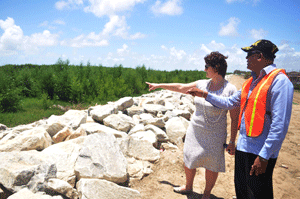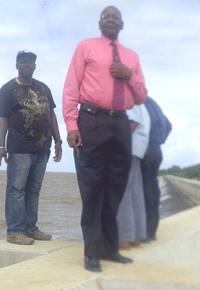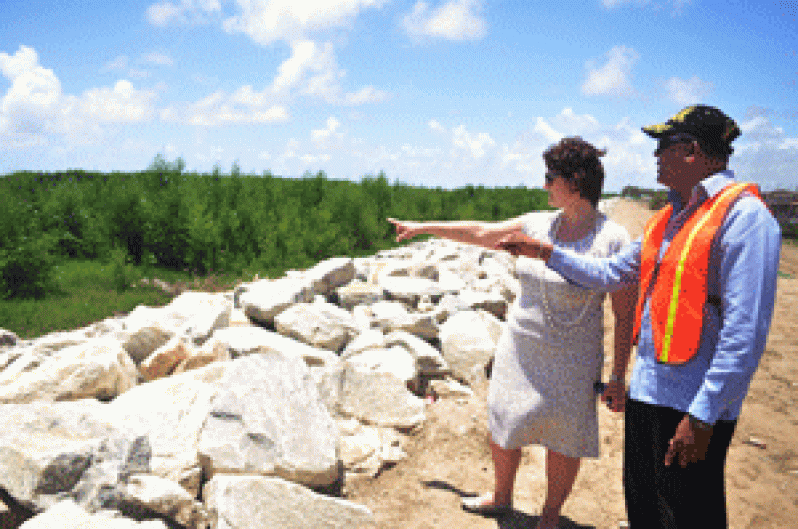EU officials impressed with funded Guyana projects
GUYANA’s geographical location has seen the government, for several years now, expending billions of dollars on its approximately 430 kilometres shoreline to guard against the sea level rising and adversely affectng the majority of Guyanese living on the coastland.  During that time, the sea has taken a heavy toll with a number of breaches at different points, the most recent occasion being the 2005 floods which resulted in heavy losses from assets and crops destruction.
During that time, the sea has taken a heavy toll with a number of breaches at different points, the most recent occasion being the 2005 floods which resulted in heavy losses from assets and crops destruction.
Consequently, the importance of having a strong sea defence system and constant rehabilitation of such structures along the coastland have been priorities of the government.
Funding for such projects has been provided by donor agencies such as the Inter-American Development Bank (IDB), Caribbean Development Bank (CDB) and the European Union (EU) under its European Development Fund (EDF) programmes cycle, which commenced in 2007.
Late last month, a high-level EU team, which included Director of the European Commission’s Directorate for Development and Cooperation in Latin America and the Caribbean, Ms. Jolita Butkeviciene; Head of the EU Delegation in Guyana, Ambassador Robert Kopecký and senior officials of the EU local office, inspected a number of critical works financed by the EDF and being executed by B.K. International on the Essequibo Coast and the East Coast of Demerara.
First such
The visit by Butkeviciene is the first by a high-level official from the EU headquarters, in Brussels, Belgium, since the commencement of the EU/Guyana relationship.
The team also inspected enhancement works on the Ogle Airstrip, which was also undertaken by B.K. International, headed by Mr. Brian Tiwarie, with part funding by the EU.
Tiwarie was accompanied on the inspection by Mr. Eton Chester, Managing Director of Citizen’s Bank, B.K’s local financing institution; Chief Engineer (Hydraulics), Mr. Basdeo Roopnauth and other engineers associated with the company.
The airport job, which involved the runway being lengthened to accommodate regional flights, was commissioned on Thursday.
The seawall is also critical to safeguarding the investments in infrastructure and improved agricultural production in Guyana and, of significance, is the modification of the design, using a rock solution on a section, in preference to the initial design.
Roopnauth told the Guyana Chronicle that Butkeviciene was impressed with the modified accomplishment, which, he said, saved the government 900,000 euros.
He said the EU functionaries had also expressed satisfaction with the sea defence works on the Essequibo Coast and his company feels vindicated for its concerted efforts to convince the local authorities that the modification is much better when the effects of climate change are considered.
Cost effective
Roopnauth said the job was cost effective and would guarantee a longer life span of the structure.
He pointed out, too, that the natural regeneration of one six months old mangroves at Clonbrook, on the East Coast of Demerara, which is credited to the use of the rip-rap fashion, was of particular interest to the top EU official.
Mangrove forests have proven to be an invaluable complement to the seawalls as the trees aid in reducing the force of the waves as they reach the shore and, crucially, allow for the active build-up of the shoreline through accretion.
The vegetation also plays a role in stabilising the country’s dynamic coastline, which experiences both accumulation and removal of sediment by huge mud banks.
To this end, there is a consistent thrust by the government, through projects funded by the EU to re-grow mangroves along the seashore to help protect the shoreline.


.jpg)











